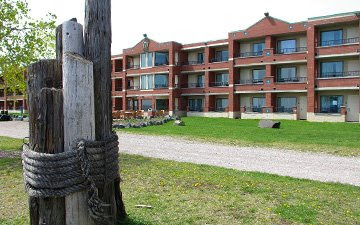
2009 May Faculty Peer Review Workshop by LSC
Summary of Notes – James FalkofskeThe last two days I was in Duluth, MN attending the Online Faculty Peer Review Course Design Workshop presented by Susan Brashaw and Amy Jo Swing of Lake Superior College. Here are some notes from the workshop about their faculty peer review process for online courses.
Peer Review is Strictly Voluntary Participation
- Instructors are invited to participate, but there is no requirement (due to labor contract concerns of “on-ground” versus “online” responsibilities and review).
- About 60% of the online faculty members have been part of the review process at some point.
- Faculty volunteer to have their courses reviewed; they aren’t eligible for this until they have had the training.
- A coordinator (Susan Brashaw) is given release time to recruit faculty, recruit courses for review, handle paperwork, and provide training to reviewers. Also, the coordinator helps “teach how to teach” online (which is more than having technical training on how to use D2L tools). This was seen as a critical factor in the ongoing use of the peer review process.
Review Process
- Rubric adapted from the Maryland Online Quality Matters Rubric while still under the FIPSE Grant (which required results be public and sharable). LSC allows others to use, adopt, and adapt their rubric. The LSC rubric is simplified to meet the best practices and needs of LSC.
- LSC review process uses local faculty only (no outside reviewers), and instructor / designer must approve the review team prior to review.
- Reviewers receive 2 to 3 hours of instruction prior to their first review. Faculty are only eligible to become a reviewer after one of their own courses has been reviewed.
- Three reviewers are assigned to review a course, and one is designated the leader who meets 1-on-1 with faculty designer and has other reporting responsibilities. The leader receives a $300 stipend for this activity.
- Instructor completes a checklist – helping reviewers identify where certain standards are being met in the course.
- A passing score of 60/70 means course is “certified;” otherwise the course is scored as “in progress.” Roughly half the courses are given “in progress” scores upon first review.
- Even if a course is “certified,” the reviewers provide recommendation for improvements to the course design, flow, and appearance. The review process examines structure and design much more than “quality of content.”
- “In process” courses can have the leader of the review team review the changes to determine if the course then meets certification standards.
- All the information is held as confidential; review team signs statements of non-disclosure; faculty may choose to share results with administrators, but administrators alone cannot request results from any review. All documents (paper and electronic) are “shredded” after one year.
- Since starting 4 years ago, 53 courses have been reviewed and 21 reviewers trained (review of roughly 15 courses per year)
- Reviews are only made for fully online courses; there are thoughts of expanding the review process to hybrid / web-enhanced courses
D2L Best Practices Notes
Much of the workshop was sharing of best practices for online instruction and course design; I enjoyed hearing that other faculty were using the same types of online activities which I recommend, and I was able to provide some technical assistance to participants in specific D2L settings and tools.- The LSC Presenters felt this was especially important: D2L Site Administrators should turn on all possible tools for faculty to control themselves; this allows faculty to be innovative and be able to have maximum control over the presentation of their online courses. This includes changing navigation bars, creating custom widgets, and modifying course run dates.
- Provide faculty with a “Starter Course” from which they can copy & paste ideas they want. The course provides brief “how to” instructions for embedding different types of content, changing D2L tool settings, etc.
- The processes of satisfying the rubric can be simplified by creating special tools that faculty can cut and paste into their courses (the official Virtual Campus Student Support Widget as one example)
- Faculty and students need to have access to technology tutorials which demonstrate how to use tools (D2L, wikis, photo editors, etc.) for online courses.
- Encourage students to express creativity using Web 2.0 tools, but don't make the use of Web 2.0 tools a requirement for an individual student's assignment.




No comments:
Post a Comment